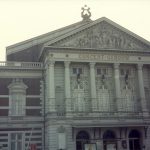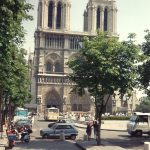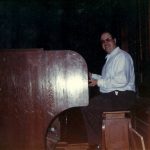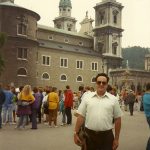My Musical Career|Part Thirty Nine
The Year 1990
Continuing on with this saga, one would think that 1990 would be an easier year than the past three. However, that was not reckoning with our music director, Mariss Jansons and both EMI, our recording company and the orchestra administration. The year 1990 would see two recordings for EMI, a tour to Spain, France and Holland (including a one concert return to the Corneille Chapel in Rouen) and in the second half of 1990, our first visit to the prestigious Salzburg Festival. The percussion section of the orchestra was now complete with Christian Berg on board as principal, Trygve Wefring as assistant timpanist and percussionist, and Per Erik Thorsen as third percussionist. There wasn’t as yet a provision for fourth percussionist, so Bjørn Løken, Einar Fjærvoll, and Morten Belstad continued to help out as needed.
One thing that stands about our music director was that he was always looking to improve in whatever he undertook, whether as a guest conductor or responsible for the musical well-being of a symphony orchestra. His period with the Oslo Philharmonic was a golden age in the orchestra’s artistic growth and international recognition. Touring and recording were an integral part of the orchestra’s artistic growth, and Mariss was responsible in large part for this.
By 1990, he had accomplished a lot of this, what with our visits to the BBC Proms in 1987 and 1989, our trips to the U.K. in 1984 and 1988, our trips to Italy and Spain in 1987, and our US tour in 1987.
The focus of our tours in 1990 would be twofold: First, Spain (two concerts- one in Seville, and one in Madrid); France – one concert in Rouen, and one in Paris –which would be the first time that the orchestra played there), and the highlight of the tour – a concert at the famed Concertgebouw in Amsterdam, Holland. This tour would take place in June of 1990, just before the orchestra would take its summer holiday. The second tour would occur in August and would be a rather short tour: only two venues – Linz and Salzburg, Austria. Salzburg is the birthplace of Mozart and home of the world famous Salzburg Festival. We were to perform one concert at the Festspielhaus, which for us was a signal honor. This was an extremely important concert for us, as we hoped to be re-invited. The Linz concert was also important (actually all concerts are) as a warm-up for Salzburg.
More about the tours later on in this blog.
Our recording schedule was limited to two sets of sessions for 1990: the music of Bela Bartok in January, and the music of Jean Sibelius in September, just after our appearance at the Salzburg Festival. Needless to say, I was very happy with both the tour destinations and the recording program for the year.
I’ll discuss our recordings only briefly as I plan on going into more detail in a separate blog. Mariss chose two of the most difficult works in the Bartok canon: his 1945 “Concerto for Orchestra” and his “Music for Strings, Percussion and Celesta” which dates from 1936. These were to be recorded in January 1990. For the September sessions, Mariss and EMI agreed on the music of Sibelius: His 1st Symphony; Suite from “Karelia”, and “Finlandia. All of these works, both Bartok and Sibelius have great timpani parts. (I would have said epic, but I risk hyperbole.)
Timpani-wise, I was sitting pretty. The orchestra owned the five Hingers, and the four Light Metropolitan Bs and the 31 inch Continental chain. The Ludwigs were sold off to one of the local city brass bands, and we had calfskin on both sets. The orchestra’s purchase of a large amount of percussion equipment (including chimes, bells, tam-tams, etc.) had given our section more flexibility. The orchestra had developed more depth, and we were more than ready to record this repertoire.
The recording sessions themselves went surprisingly well. We rehearsed the Concerto for Orchestra and played in concert before the sessions, and we had played the Music for Strings, Percussion and Celesta in concert in September of 1989, so we were no strangers to either work. John Fraser produced, and Mark Vigars was the engineer.
Spain/France and Holland
The regular season proceeded after we finished the sessions and before I knew it, we were rehearsing and preparing for the tour to Spain, France and Holland. The repertoire for this tour included the Shostakovich 5th Symphony, and Stravinsky’s Petrouchka (1947 version – not my favorite – I prefer the 1911 version) as well as the Saint-Saens Cello Concerto, with soloist Lynn Harrell. The Second Suite from Ravel’s Daphnis et Chloe rounded off the program, plus the usual encores. Our percussionists Christian Berg, Trygve Wefring and Per Erik Thorsen were joined by Bjørn Løken, EinarFjærvall and Joakim Nordim. This was the first tour in which I actually took the Hingers with calfskin heads on them. They were on the larger three drums…I hedged my bets and had a Remo hazy white on the 22 and an half. I was understandably a bit nervous as I had never taken the calfskin-headed timpani on tour prior to this tour. Everything up until this point on tour was done on plastic. Well, the Good Lord was with me, as the drums behaved themselves impeccably. I played all the works on tour except for the Saint-Saens, which Trygve played.I do not have vivid memories of the Spanish part of the tour, but I do know that we played concerts in Seville and Madrid. Seville is always interesting because of its Cathedral, and Madrid is, well, Madrid. I’ll never get used to concerts at 10:00 pm. I was sorry that we did not get the chance to play in Barcelona, because I found that more fascinating, especially it’s old cathedral and Sagridas Familias basilica. From Spain, it was on to France, first to our old stomping grounds in Rouen. We had been a part of the Festival Maritime d’Ete during the 1986, 1987 and 1988 seasons and were well received there, and missed going in 1989. During those seasons we played two concerts, all at the Cornielle College Chapel. This year, were to do only one, but I do know that they wanted us to come. It turned out to be the last time we were able to play there. Shostakovich’s 5th Symphony was the main work of the concert, and Mariss and the orchestra gave their usual spirited account of it. This was the place I was most concerned about using calfskin, as it was a church, and it had a tendency to be a little on the damp side. However, the weather was perfect, and the drums sounded glorious, making me wish I had done this earlier. We were well received, and enjoyed our visit to Rouen. I remember that there wasn’t much free time, but I made it a point to visit the Vieux Marche, where Joan of Arc was executed by the English. I also remember visiting a smaller church and had the opportunity to hear the tail end an organ recital. The organ was a typically French instrument of the Cavaille-Coll type and I was amazed at how “ripe” the reed stops sounded. Not bad at all, just totally different. Very powerful. Then it was on to Paris.
This would be our first visit to the City of Light. It was also a bit of a flying visit, as arrival, rehearsal and concert were all on the same day, although there were a few hours to walk about. With Paris, like London, one needs a t least a week , and I could have stayed there forever. The venue for our concert was, unfortunately not the Theatre du Chatelet, but a venue close by. Perhaps one of the lesser halls. Memory fails me here, but I remember the interior being of wood with green plush seating. I do remember that the program included the Shostakovich 5th Symphony and a work that we hardly ever played – either before or later. For some reason, Mariss programmed a version of Georg Frederic Handel’s Music for the Royal Fireworks. To his credit, when we rehearsed and played it in Oslo, we did it as a “big band” version, but with a lot of enhancements that were more in keeping with baroque style. I am glad I had the Hingers with calf, as the two middle drums (with me playing with wooden mallets very much like baroque mallets) worked extremely well. The concert went off very well. Earlier in the afternoon, I had taken whatever free time there was to visit Notre Dame Cathedral, which was not very far from our hotel or our concert venue. I have a fascination for cathedrals, and having been familiar with Notre Dame through books and articles, I wanted to visit the church.
Fortunately, it was still open after our sound-check rehearsal, and I spent an hour or so looking over the church. One thing impressed me was its extreme age, and the beauty of the church. It is absolutely gorgeous, and well maintained. I remember how dark it was inside, but that is characteristic of all older gothic cathedrals.
After the concert, a few of us went to a café right off of the River Seine and across from Notre Dame. There, we enjoyed a good meal (I had a margherita pizza – delicious) and conversation and we watched the crowds stroll by. It was a lovely evening, and a good conclusion to our short visit to Paris. It was now on to Amsterdam.
Amsterdam – home to the world famous Concertgebouw and its equally famous Royal Concertgebouw Orchestra – was the final and perhaps most important stop on our tour. I had been a fan of the orchestra for many years – treasuring the recordings of the orchestra under Bernard Haitink and Eugen Jochum and just starting to collect those made by the orchestra and its music director of the day, Riccardo Chailly. We had two days in Amsterdam. One was a travel day, with enough time to do a little sight-seeing, and the other was devoted to rehearsal and concert. The program was made up of three works: Stravinsky’s 1947 version ofhis ballet “Petrouchka”; The Saint-Saens Cello Concerto (with Lynn Harrell as soloist); and the Second Suite from Ravel’s “Daphnis et Chloe.”
I remember spending the free time when we arrived in Amsterdam walking about the town, trying to get a sense of it. I remember the Staats-Museum and remarking on how castle-like it was. I went by the Concertgebouw and loked over the outside, then went and had dinner.
When we went to the hall the next day for out sound check, I marveled at the beauty of the inside of the hall. The large pipe organ behind the orchestra and among the choir seats – all of these were familiar from pictures of the hall and I was anxious to see how our orchestra sounded here in the Concertgebouw, which was one of the few halls renowned for its excellent acoustics.
To be honest, I felt a little let down acoustically at least at first. It was to my ears over-reverberant. I was hoping that it would dry up a little at the concert. Our rehearsal was just prior to the concert, so I had my white shirt and dress pants on for the rehearsal, and I remember just before the rehearsal started having my picture taken at the console of the organ.
In the end, the concert was a great success. Once there was an audience in the hall, the acoustic dried up just enough to provide an excellent sound, and all three works went off extremely well. It was a nice way to end the 1989-1990 season and to return home for our Hollmenkollen summer concert, and then for a well-deserved six week vacation.
Salzburg
August 1990 was the month in which Mariss Jansons and the orchestra made their first appearance at the prestigious Salzburg Music Festival which takes place naturally enough in Salzburg, Austria, the birthplace of Wolfgang Amadeus Mozart. I had been looking forward to this since the announcement to the orchestra that we would be making a one-concert appearance there. In addition to bring the birthplace of Mozart and the province of much of the musical activity of the late conductor Herbert von Karajan (who died the previous July at the age of 81), the area around Salzburg was known as the setting for much of the famous 1965 motion picture “The Sound of Music”, which is still one of my favorite movies. I was not only looking forward to playing with the orchestra at the festival, but to do a little sight-seeing if there was time. I wanted to actually see the cathedral and city square, and perhaps visit Mozart’s birthplace. The trip was planned for five days – a travel day to Linz, where we would play in the program for the local audience, then travel to Salzburg, rehearse and perform it there before returning to Oslo. The program consisted of three works: The Suite from Edvard Grieg’s “Peer Gynt”, followed by his Piano Concerto in A minor. The Tchaikovsky Sixth Symphony, the “Pathetique” would conclude the concert, and there were the usual encores.
The orchestra used the first days of August to rehearse and I believe we played a concert in Oslo before going on tour. That was our usual procedure before going on tours, and it stood us in good stead.
Having more confidence in playing on calfskin on tour, I used the Hinger timpani and they were just the right choice and thankfully, behaved themselves, meaning there were no crises as to pitch, etc.
The flight down was uneventful and we arrived in Linz safe and sound. The concert in Linz was excellent. It has an excellent concert hall and the orchestra sounded just fine. Everyone’s performance was outstanding and all were looking forward to doing even better when we reached Salzburg!
The concert went very well, especially the Tchaikovsky. We received a standing ovation and played our usual encores. There was only one slight glitch. It occurred at the opening of the Grieg Piano Concerto. I played my opening roll, and instead of an a-minor chord from the solo piano, the chord was atonal! For some reason, the pianist missed one of the key notes, and while he immediately recovered and played the rest of the concerto superbly, it rattled us a little. The soloist is a superb musician as he proved then and on subsequent concerts with us. It just goes to show you that sometimes even the greats have their moments. Nonetheless, it was a great success, and earned us an invitation to return.
We returned to Oslo in great spirits.
Second Recording Session – Sibelius
I’ll conclude this post with a little about our second recording of the year 1990. It was decided earlier on to include some works of Sibelius in our assignments for EMI, and for these September recording sessions, Mariss and the powers that be decided on the 1st Symphony, with the Karelia Suite and Finlandia as fillers. David Murray and Mike Clements were back to do the recordings, and as we had the symphony in our heads and hands – having played it many times, all that needed was a touch up. I’ll say more about this in a separate blog post. Suffice to say, that the sessions went well!
Here’s a link to our recording of Finlandia to spice up your day. Enjoy!





Recent Comments